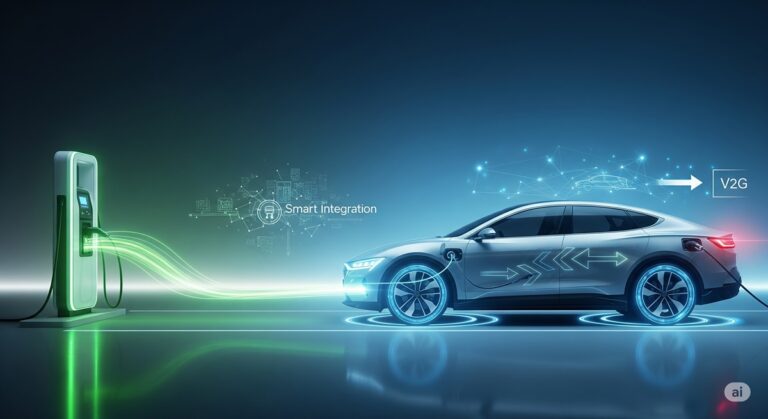EV Environmental Impact: The Full Truth—Are Electric Cars Truly Greener Than Gasoline?

The hum of an electric vehicle (EV) glides silently past, a symbol of progress in our global push towards sustainability. Yet, for every electrifying success story, a lingering question often surfaces: are electric cars truly greener, or does their environmental impact simply shift from the tailpipe to the power plant or even the mine? It’s a critical question, deserving of a clear, data-backed answer that moves beyond headlines and delves into the full lifecycle.
This article isn’t just another debate; it’s a comprehensive, myth-busting investigation into the EV environmental impact. We’ll meticulously compare EV vs. gasoline emissions across their entire lifecycle—from the extraction of raw materials and the manufacturing line, through years of driving, to their eventual end-of-life and recycling. Our goal is to provide you with the true environmental cost of EVs, substantiated by credible sources and the latest scientific data, so you can confidently understand why electric cars are greener and how their environmental performance is continuously improving.
- 1. The Carbon “Debt”: Unpacking EV Manufacturing’s Environmental Footprint
- 2. On the Road: EV Operational Emissions & The Grid Factor
- 3. Beyond Emissions: Unseen Environmental Benefits of EVs
- 4. The End of the Road: EV Battery Life, Recycling & Second Life
- 5. The Road Ahead: How EVs Are Becoming Even Greener
- Conclusion: The Unfolding Story of EV Sustainability
- Frequently Asked Questions (FAQs) About EV Environmental Impact
1. The Carbon “Debt”: Unpacking EV Manufacturing’s Environmental Footprint
Let’s address the elephant in the room first: the manufacturing process. It’s a common criticism that producing an EV, particularly its battery, carries a significant upfront carbon footprint that might negate its environmental benefits. And to be clear, there’s a kernel of truth here.
Compared to a conventional internal combustion engine (ICE) vehicle, an EV’s manufacturing phase, especially battery production, does typically generate a higher initial carbon footprint—sometimes 1.3 to 2 times more greenhouse gas (GHG) emissions. This “carbon debt” is largely due to the energy-intensive processes involved in creating battery cells and packs. Research indicates that battery production alone can account for 40-60 kg CO₂ per kilowatt-hour (kWh) of battery capacity, making up roughly half of an EV’s “vehicle cycle emissions.”
The journey of an EV battery begins deep within the Earth. Critical minerals like lithium, cobalt, nickel, and graphite are extracted, a process that undeniably has localized environmental impacts. Mining operations can consume significant amounts of water (e.g., for lithium extraction) and lead to land disruption. Ethical concerns, particularly around cobalt mining in regions like the Democratic Republic of Congo, highlight the social dimensions of raw material sourcing. The demand for these minerals is projected to surge dramatically in the coming years—for instance, lithium demand by nearly 90% and copper by 40% by 2040, according to the IEA.
However, it’s crucial to understand that this manufacturing footprint is not static. Battery manufacturers are actively investing in
- Cleaner Energy Sources: More gigafactories are being powered by renewable energy, reducing the emissions associated with battery production.
- More Efficient Processes: Innovations in battery chemistry and manufacturing techniques are leading to less energy-intensive production.
- Responsible Sourcing: Industry initiatives like the Global Battery Alliance are working towards greater transparency and certified sustainable mining practices to mitigate environmental and social impacts.
While this initial “debt” exists, it’s only one part of the story.
2. On the Road: EV Operational Emissions & The Grid Factor
Here’s where the EV vs. gasoline emissions debate truly tips in favor of electric cars. Once an EV leaves the factory, its operational impact—or lack thereof—becomes its greatest environmental asset.
The most immediate and undeniable benefit of driving an EV is zero tailpipe emissions. This means your electric car isn’t spewing harmful pollutants like carbon dioxide (CO2), nitrogen oxides (NOx), sulfur oxides (SOx), or particulate matter directly into the air you breathe. This absence of localized pollution has a profound positive impact on urban air quality, reducing smog and improving public health.
However, the question often arises: “What about the electricity generation?” This is where the EV charging environmental impact comes into play, and it’s heavily dependent on your local electricity grid mix.
- The Grid’s Role: EVs are only as clean as the electricity that powers them. If your electricity comes primarily from coal-fired power plants, your EV’s “well-to-wheel” emissions will be higher than if you charge it with hydropower or solar.
- Still Cleaner, Even on a Dirty Grid: Remarkably, even when powered by an average grid that includes a significant portion of fossil fuels, EVs are still generally cleaner than gasoline cars. Why? Because EVs are simply far more energy-efficient. They convert a much higher percentage of energy into motion (around 65-69% efficiency) compared to gasoline cars (a mere 16-25% efficiency), meaning they require significantly less energy to travel the same distance. For instance, the EPA highlights that EVs, on average, waste only about 31-35% of energy, while petrol cars waste 75-84%.
- Data Backs It Up: In the US, even with the current average electricity mix, EVs release significantly less CO₂ per mile than gasoline cars. According to Recurrent Auto, an average EV produces around 110 grams of CO2 per mile, compared to 410 grams of CO2 per mile for a typical gasoline car.
- The Breakeven Point: This efficiency is why the initial manufacturing “carbon debt” is repaid surprisingly quickly. Research from Recurrent Auto and ICCT indicates that an EV typically becomes “greener” than a comparable gasoline car after just 1.4 to 1.9 years of driving, or approximately 11,000 miles (17,700 km). Beyond this point, the carbon footprint of electric cars continues to diverge favorably from their gasoline counterparts.
- A Decarbonizing Grid: The good news is that electricity grids worldwide are rapidly decarbonizing. In the US, for example, over 80% of new electricity generation capacity added in 2021 came from renewable sources. As grids become cleaner, the environmental advantage of EVs grows exponentially, cementing their role as the sustainable transportation solution.
3. Beyond Emissions: Unseen Environmental Benefits of EVs
The electric vehicle benefits the environment narrative extends far beyond just reduced carbon emissions. EVs offer a host of “unseen” advantages that contribute to a healthier planet and a better quality of life:
- Improved Local Air Quality: This is perhaps the most immediate and tangible benefit. With zero tailpipe emissions, EVs directly reduce the concentrations of smog-forming pollutants (like nitrogen oxides and particulate matter) in urban areas. This leads to fewer respiratory illnesses, cardiovascular problems, and overall improved public health, especially in densely populated cities.
- Reduced Noise Pollution: The silent operation of EV motors, particularly at lower speeds, dramatically cuts down on urban noise pollution. This creates quieter, more pleasant living environments and can even have positive impacts on local wildlife.
- Fewer Maintenance-Related Waste Streams: EVs have significantly fewer moving parts than ICE vehicles. This translates to:
- No more messy oil changes or disposal of used oil filters.
- Reduced brake dust due to regenerative braking, which uses the electric motor to slow the vehicle, extending brake pad life and minimizing particulate emissions from friction.
- Potential for Grid Stabilization (Vehicle-to-Grid—V2G): As EV technology advances, the potential for Vehicle-to-Grid (V2G) systems grows. This allows EVs to not only draw power from the grid but also send excess energy back, acting as distributed energy storage units. This capability can help stabilize the grid, improve its resilience, and facilitate the integration of more intermittent renewable energy sources like solar and wind.
4. The End of the Road: EV Battery Life, Recycling & Second Life
One of the most persistent criticisms revolves around what happens when an EV battery reaches the end of its useful life in a vehicle. Is it just another hazardous waste problem? The answer, increasingly, is no, thanks to rapid advancements in recycling and “second life” applications.
- Battery Lifespan & Durability: Contrary to popular belief, modern EV batteries are designed for extreme durability. Most manufacturers offer extensive warranties, typically 8 years or 100,000 miles. Furthermore, real-world data from companies like Geotab suggests that many EV batteries can maintain excellent health for 20 years or even longer in a vehicle.
- The Growing Recycling Imperative: While current end-of-life battery volumes are still relatively low, they are set to explode in the coming years. Projections estimate 7 million metric tons of EV batteries will reach end-of-life by 2035, soaring to 20.5 million metric tons by 2040. This necessitates robust EV battery recycling environmental impact solutions.
- Advanced Recycling Technologies: The industry is rapidly scaling up advanced recycling processes.
- Pyrometallurgy: Uses high heat to melt down batteries and recover metals.
- Hydrometallurgy: Uses chemicals to dissolve and extract valuable metals like lithium, cobalt, nickel, and manganese. This method can recover 90-99% of critical metals.
- Direct Recycling: An emerging, even more sustainable method that aims to preserve the existing battery structure, reducing energy consumption further.
- Automation & AI: The integration of AI and robotics is making battery recycling more efficient, precise, and safer by automating tasks like disassembly and material sorting.
- “Second Life” Applications: A significant development in the circular economy for EV batteries is their “second life.” Even when a battery’s capacity drops below the optimal level for vehicle propulsion (typically 70-80%), it still retains substantial energy for less demanding applications.
- Uses: These repurposed batteries are ideal for stationary energy storage—supporting renewable energy installations (solar and wind farms), providing grid balancing services, or serving as backup power for homes and businesses.
- Market Growth: The “second life” EV battery market is projected to grow substantially, with estimates reaching USD 1.60 billion in 2025 and an impressive USD 12.42 billion by 2034, highlighting its economic and environmental viability.
- Benefits: Extending the useful life of batteries significantly reduces the demand for new battery production, limits mining impacts, and prevents hazardous waste from entering landfills, embodying the principles of a true circular economy.
5. The Road Ahead: How EVs Are Becoming Even Greener
The story of EV environmental impact is one of continuous improvement. The industry isn’t resting on its current advantages; innovation is constantly pushing the boundaries of sustainability.
- Cleaner Grids are Paramount: The single most significant factor in reducing an EV’s overall lifecycle emissions moving forward is the continued decarbonization of electricity grids. As more solar, wind, and other renewable energy sources come online, the emissions associated with charging an EV will drop even further.
- Battery Technology Advancements:
- Lithium Iron Phosphate (LFP) Batteries: These are gaining traction as they use less critical and ethically sensitive minerals like cobalt and nickel, potentially offering a lower cost and environmental footprint.
- Solid-State Batteries: A promising next-generation technology that could offer higher energy density, faster charging, and potentially require fewer materials, further reducing the carbon footprint of electric cars.
- Cleaner Manufacturing: Battery and vehicle manufacturers are increasingly committed to powering their production facilities with renewable energy, directly lowering the initial carbon “debt.”
- Sustainable Supply Chains: Initiatives like the Global Battery Alliance are actively working to establish comprehensive “Battery Passports”—digital “records that track a battery’s entire lifecycle, ensuring responsible sourcing, ethical labor practices, and transparent environmental impacts from mining to recycling.
- Vehicle Design & Lightweighting: Ongoing research focuses on designing lighter EVs, requiring fewer materials and thus reducing manufacturing impact, while maintaining safety and performance.
These ongoing advancements mean that the true environmental cost of EVs is shrinking with each passing year, solidifying their role as a critical component of a sustainable future.
Conclusion: The Unfolding Story of EV Sustainability
So, are electric cars truly greener? The data overwhelmingly says yes. While the initial carbon footprint of EV manufacturing is real, it is quickly offset by the profound reduction in operational emissions and the continuous improvements across the entire lifecycle. An EV’s “carbon debt” is typically repaid within two years, after which it becomes significantly cleaner than its gasoline counterpart.
The EV environmental impact story is not one of perfection, but of decisive progress. It’s about a rapidly evolving technology on a clear and accelerating path to greater sustainability. The perceived “dirtiness” is a transient phase, being vigorously addressed by innovations in clean energy grids, advanced battery technology, and robust circular economy practices. The move to EVs is a net positive—a crucial and powerful step that is growing greener with every passing year. Embracing electric vehicles, alongside the continued decarbonization of our energy sources and the development of comprehensive recycling infrastructures, forms a cornerstone of truly sustainable transportation.
Ready to drive change? Share your thoughts on the EV revolution in the comments below, or explore how making the switch could reduce your own carbon footprint. What steps are you taking towards a greener commute?
Frequently Asked Questions (FAQs) About EV Environmental Impact
Q1: Are EVs truly zero-emissions vehicles?
A: EVs produce zero tailpipe emissions, meaning they don’t release pollutants directly from the vehicle. However, their overall “well-to-wheel” emissions depend on how the electricity used to charge them is generated. As electricity grids become cleaner, the total emissions associated with EVs decrease significantly.
Q2: How much CO₂ is produced in manufacturing an EV battery?
A: EV battery manufacturing is the most emissions-intensive part of an EV’s production, contributing significantly to its initial carbon footprint. Estimates vary, but it can account for roughly 40-60 kg CO₂ per kWh of battery capacity. This “carbon debt” is quickly offset by the EV’s lower operational emissions.
Q3: How much cleaner is an EV than a gasoline car over its lifetime?
A: Over their entire lifecycle, electric cars are demonstrably greener. Global studies show they produce, on average, about half the greenhouse gas emissions of comparable gasoline cars. An EV typically “breaks even” on its manufacturing emissions after 1.5 to 2 years of driving, after which it becomes increasingly cleaner.
Q4: What happens to EV batteries at the end of their life?
A: EV batteries are designed for longevity and are increasingly subject to robust recycling and “second life” applications. Batteries retaining 70-80% capacity are often repurposed for stationary energy storage (e.g., for homes or grid balancing), while advanced recycling technologies recover valuable materials like lithium, cobalt, and nickel for use in new batteries, promoting a circular economy.
Q5: Does where I charge my EV affect its environmental impact?
A: Yes, absolutely. The carbon intensity of the electricity grid from which you charge your EV directly impacts its overall environmental footprint. Charging in regions with a high percentage of renewable energy (solar, wind, hydro) results in a much lower carbon footprint than charging in areas heavily reliant on fossil fuels.



